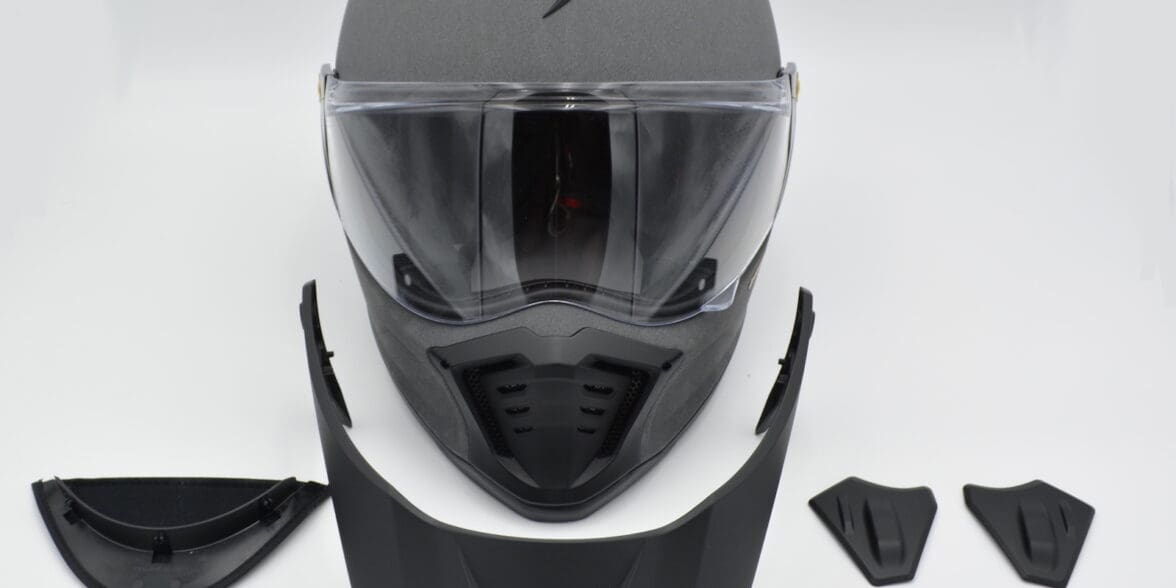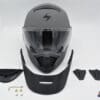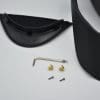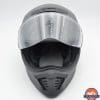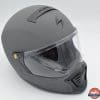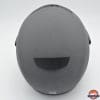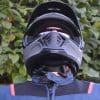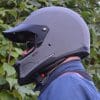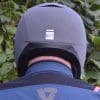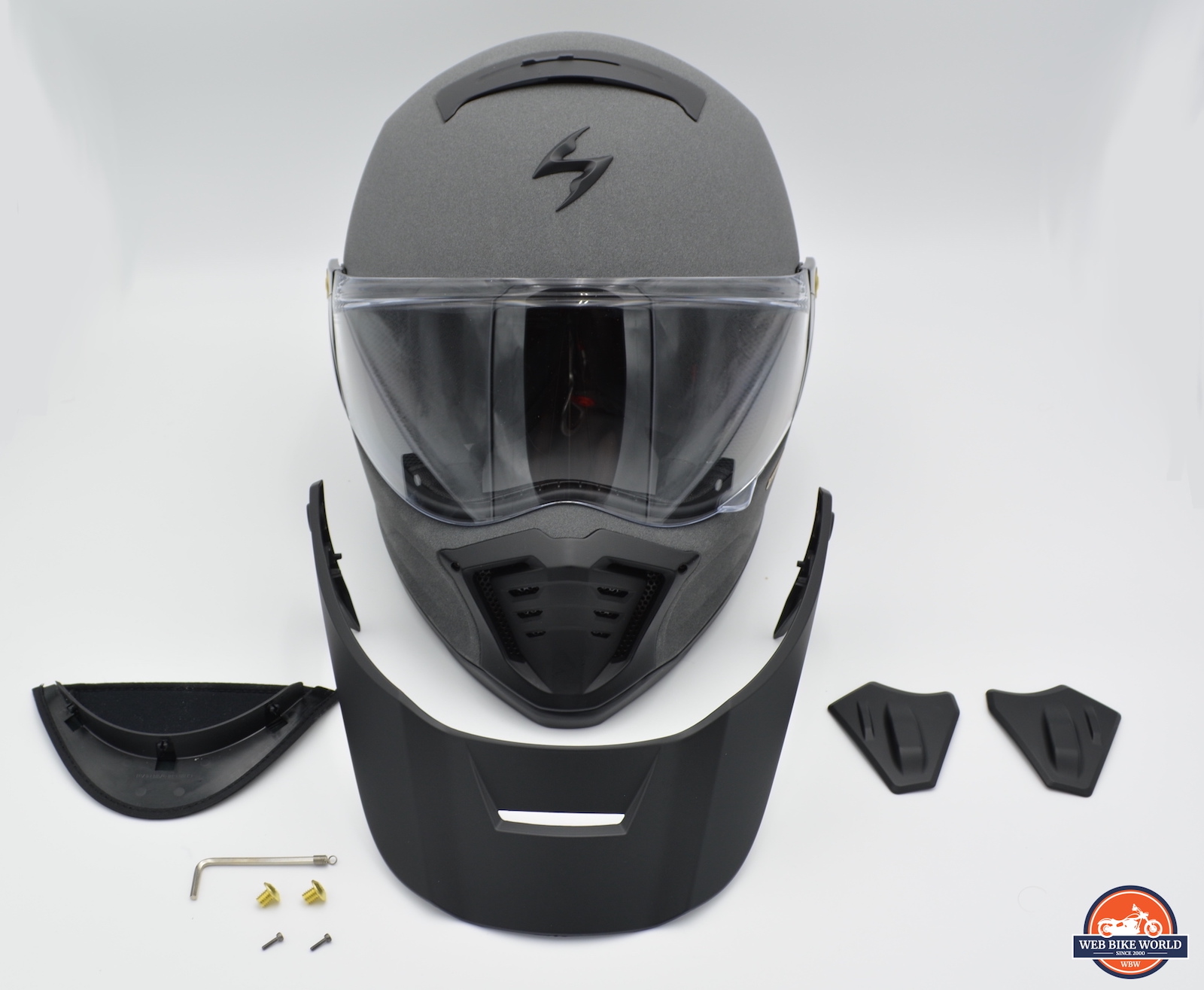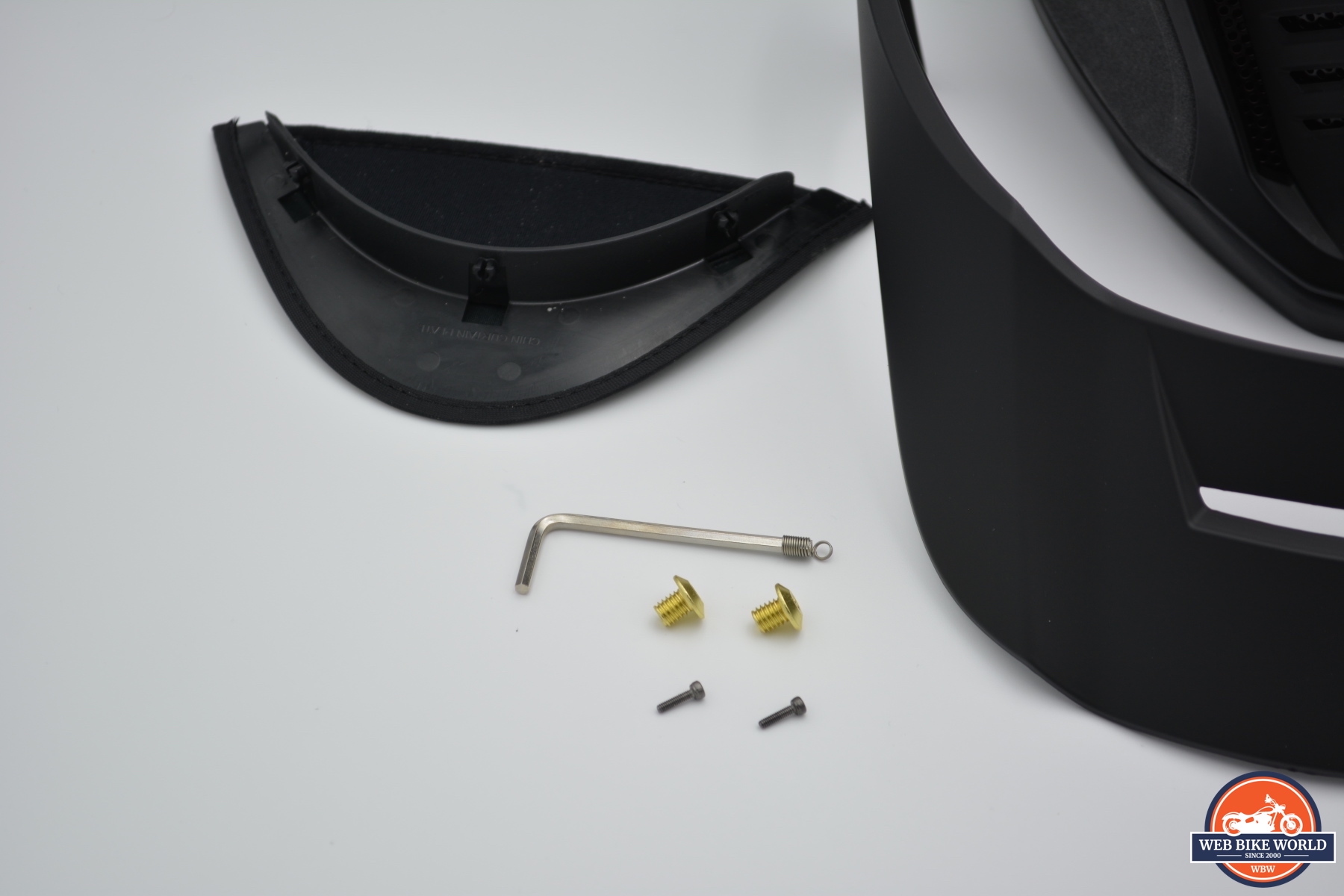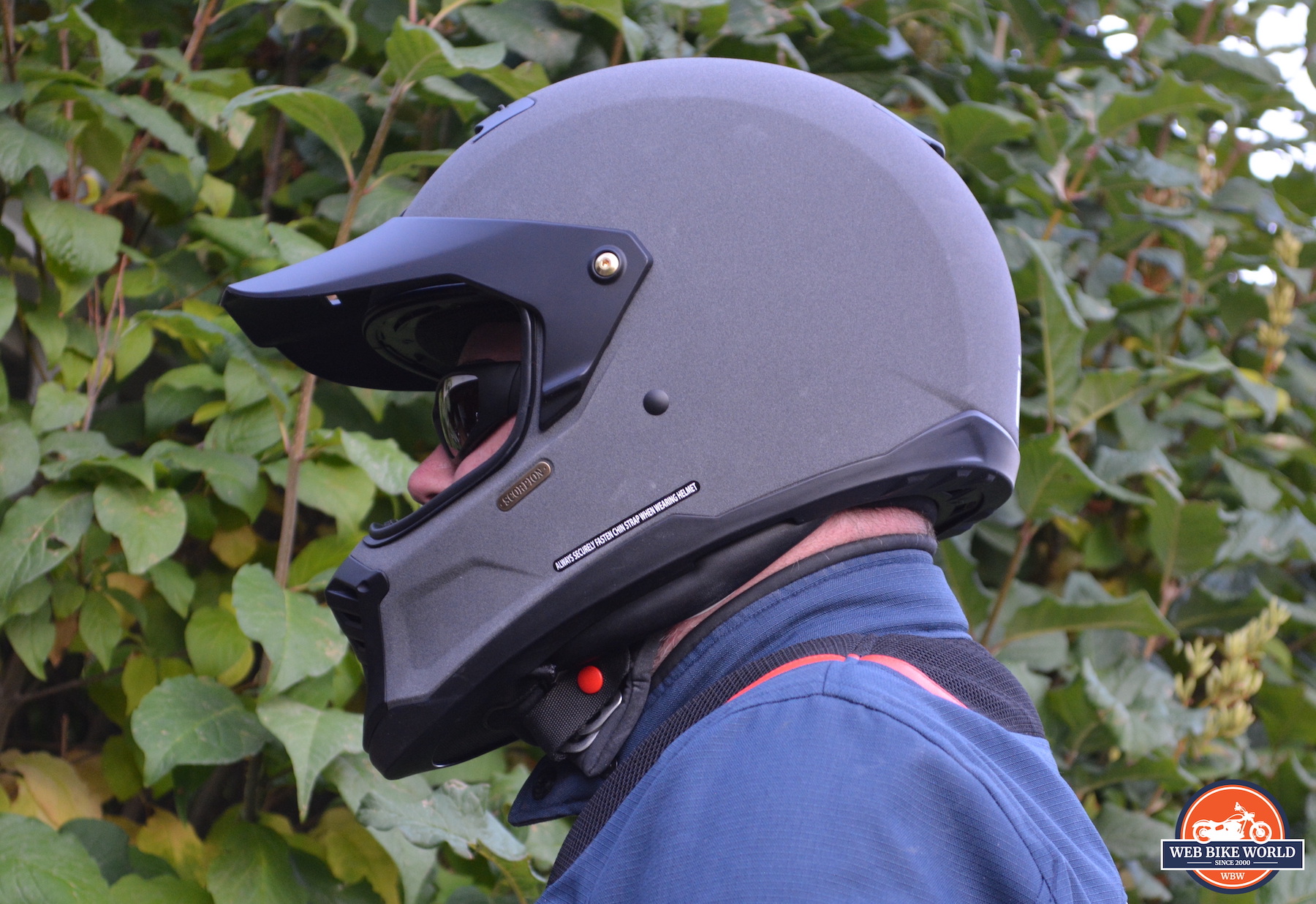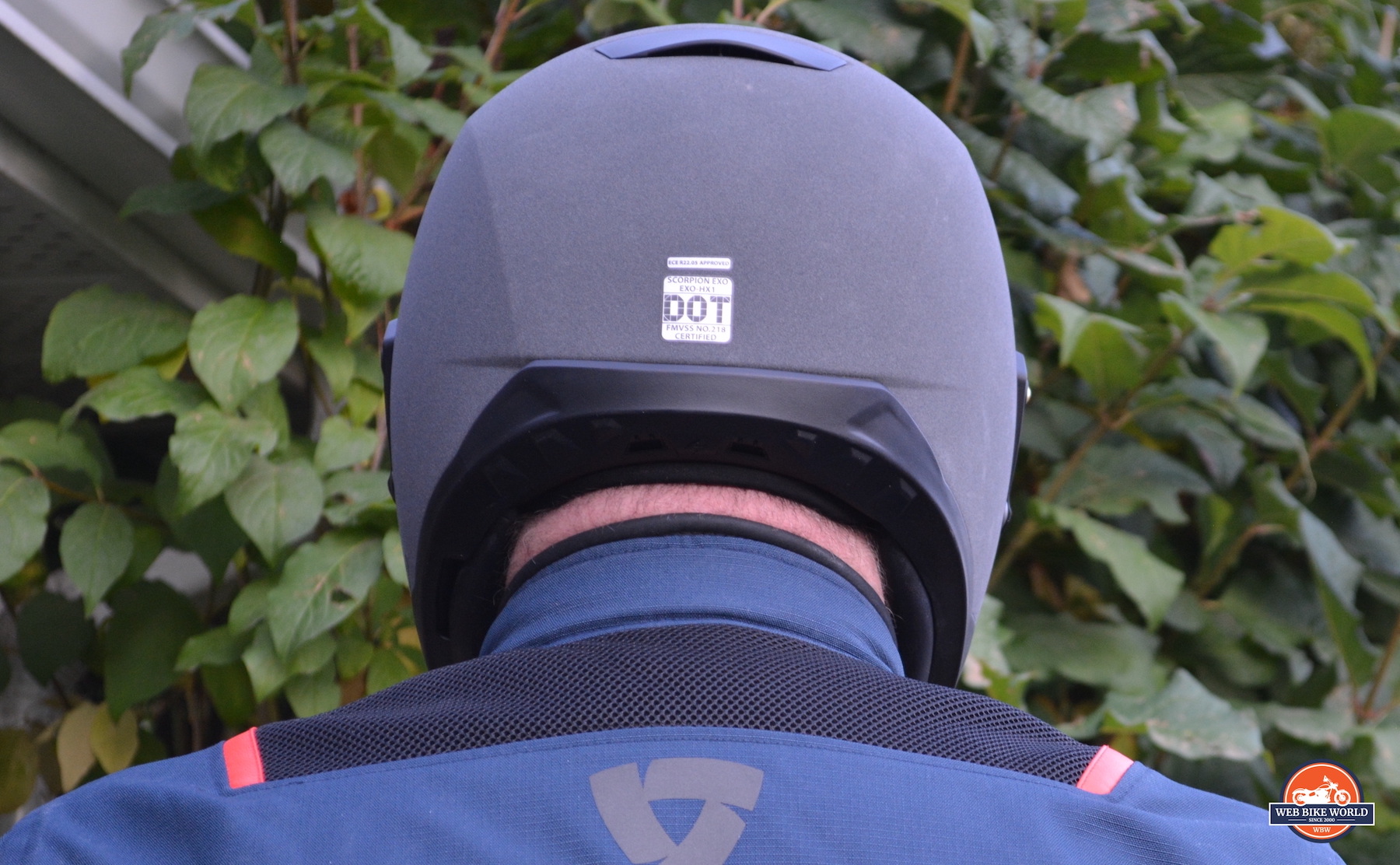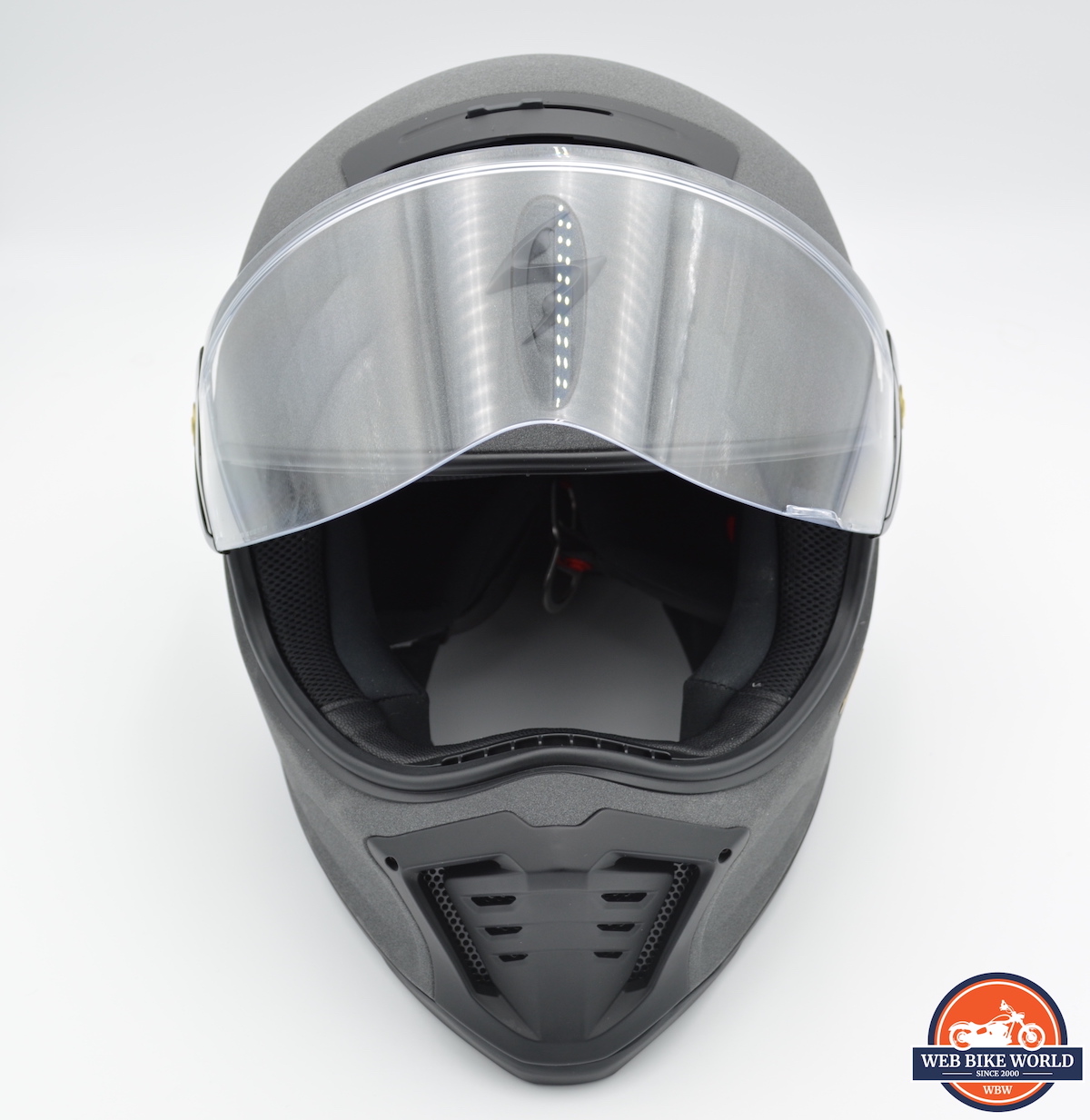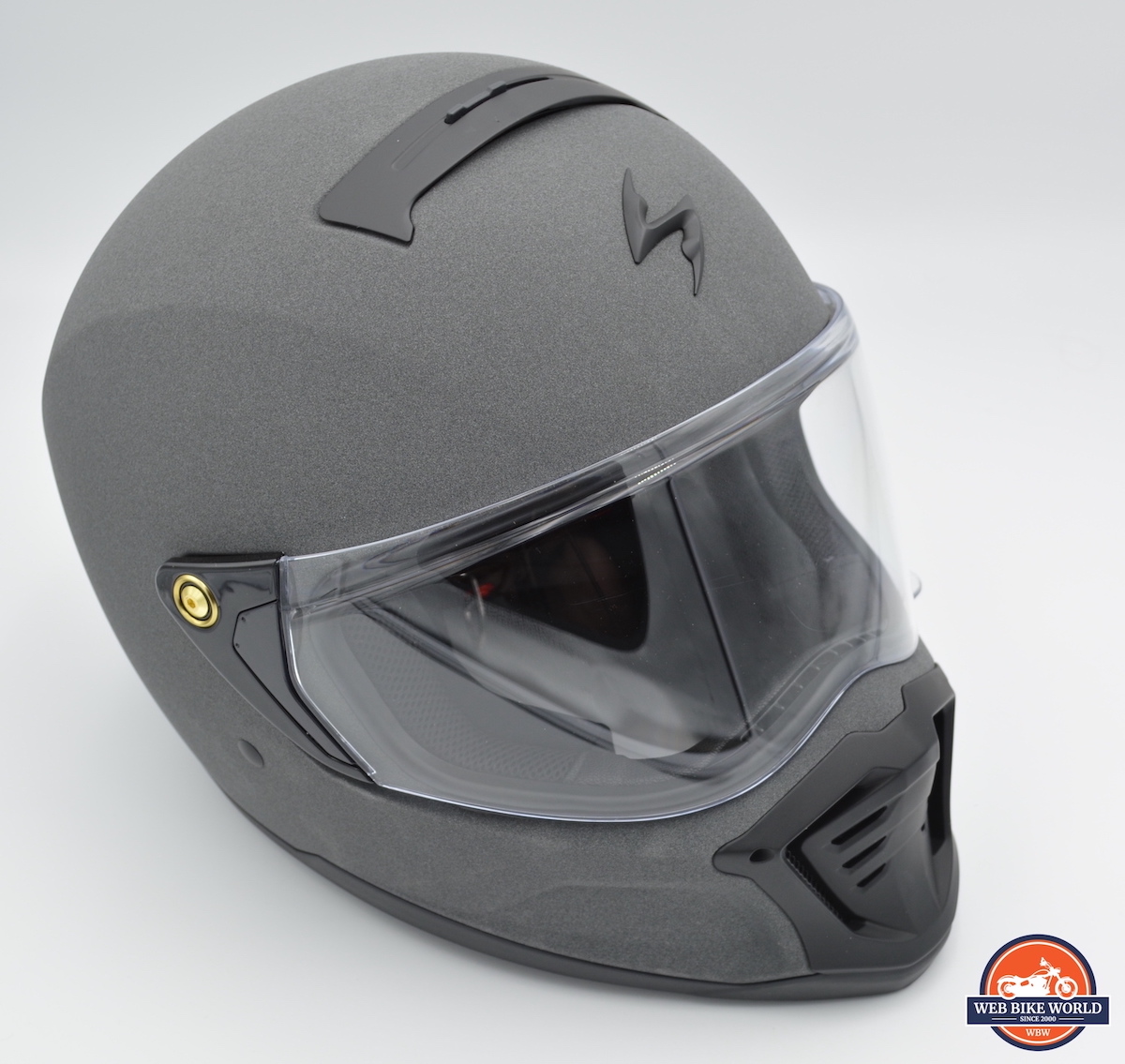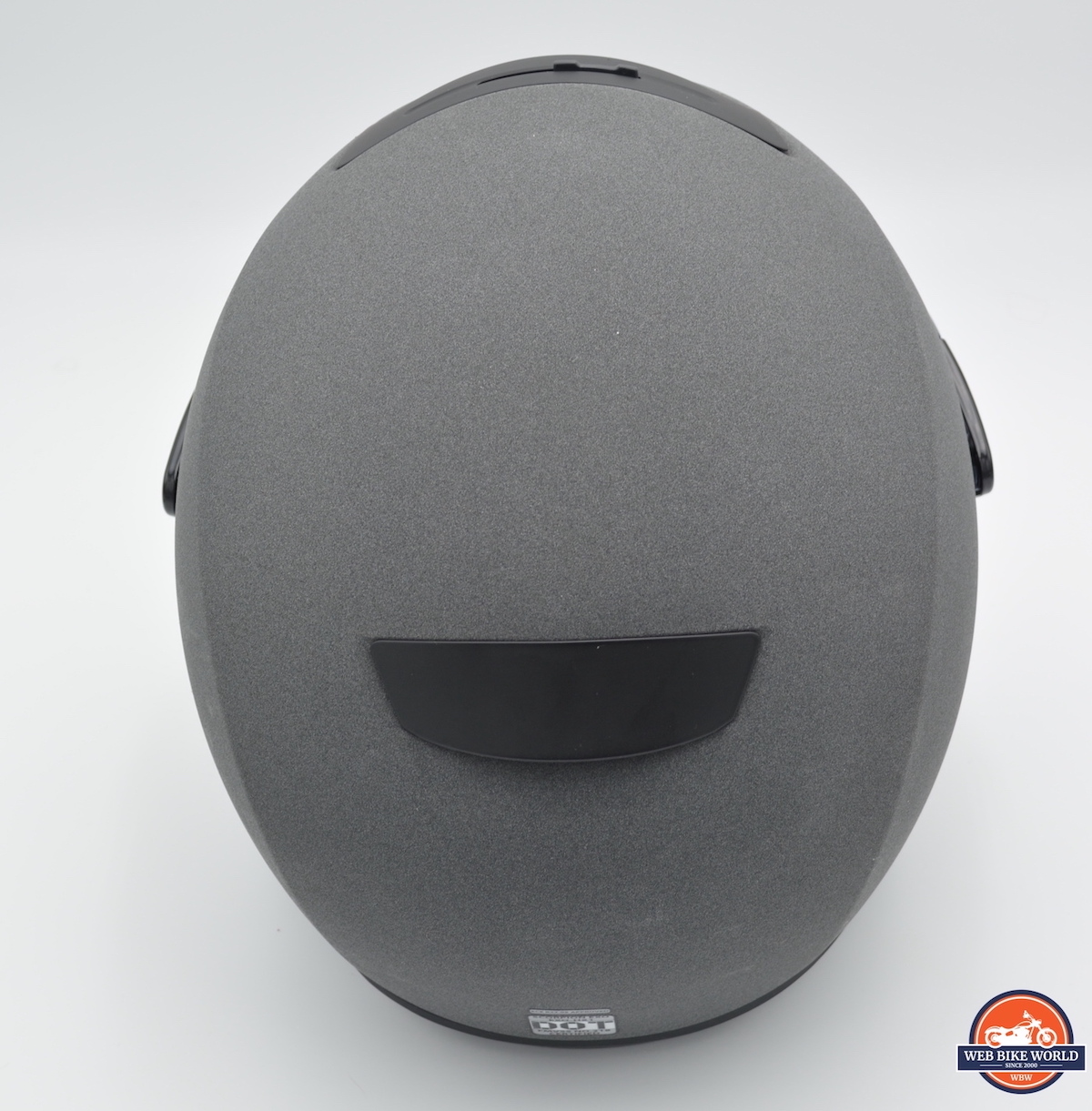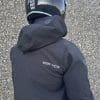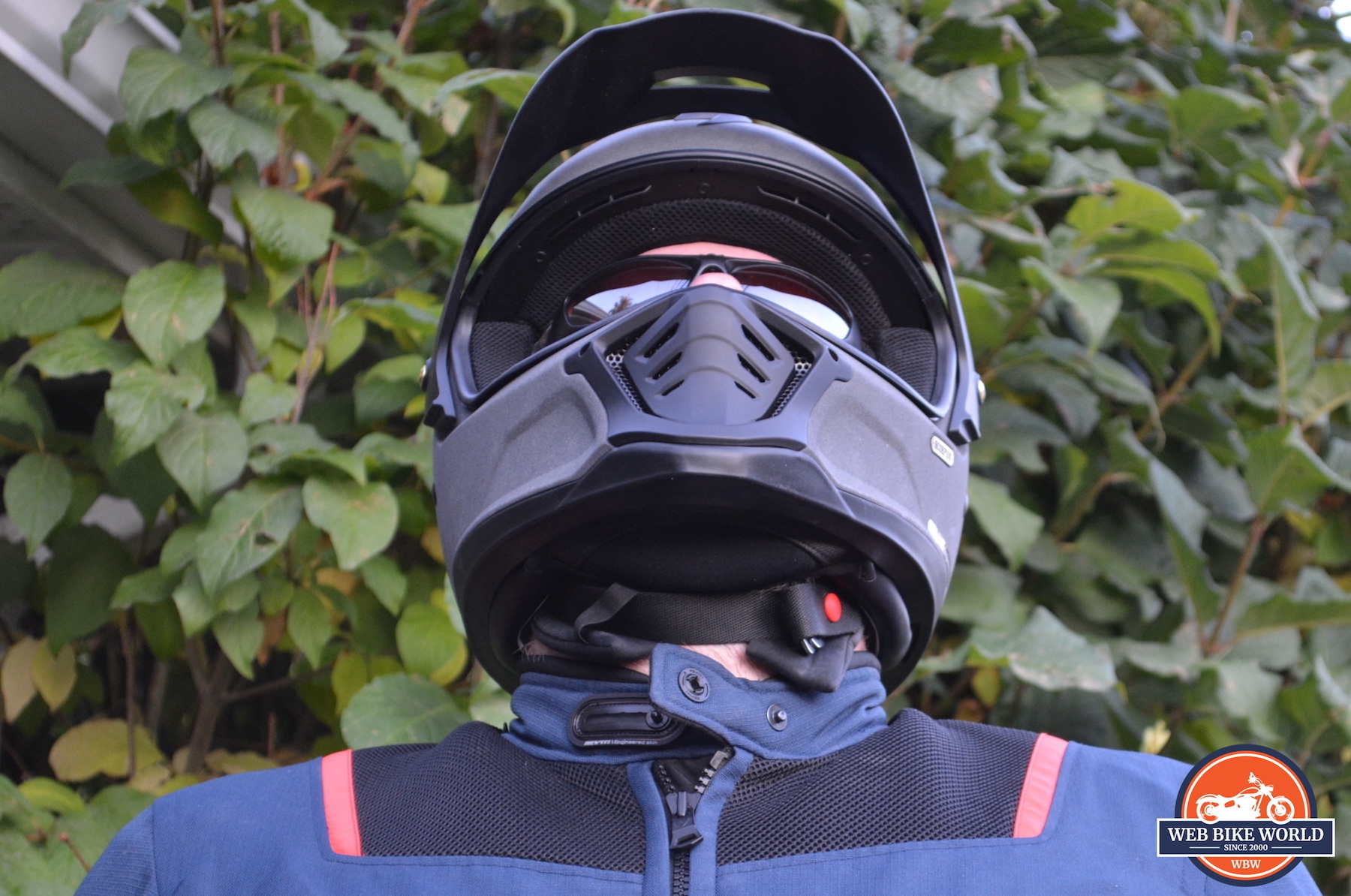In the world of motorcycles, there are about as many types of bikes as there are riders for them. Some love to ride sportbikes, some love to ride cruisers, others go for ADV bikes or dual sports. Each style of bike also seems to come with its own distinct style of gear, with the full-body touring suits of the adventure riders, the sporty, race fit gear of the sport riders, the leather jackets, and riding jeans of the retro riders, and so forth.
What Scorpion saw in amongst all these styles of riding is an opportunity to hit, at the very least, three different groups with one helmet, the HX1. It has the retro looks of the earlier full-face helmets, the shape and visor of a sports helmet, and the sun peak and goggle compatibility of an ADV helmet.
When something is designed to suit so many different types of riders, the thought, unfortunately, does always pop into the mind about what may have potentially been sacrificed for wider market appeal. It is something that is seen in TV shows, movies, video games, music, and, yes, Powersports. As we pride ourselves on being 100% honest about everything we review at webBikeWorld, it was up to me to find out if the Scorpion EXO-HX1 really is a jack of all trades, master of all, or if something was sacrificed along the way.
About Scorpion
Scorpion Sports USA is a subsidiary of Kido Sports, which is a South Korea-based motorcycle helmet and gear developer that has been in the helmet business since 2001. The Scorpion website likes to make mention of a number of global facilities, including a couple in the USA, but all of their helmets are manufactured in China.
The helmets are designed by an international team of helmet engineers from Korea, Europe, and North America and manufactured to strict tolerances. Given that they’re the official helmet supplier to many global racing stars, don’t let the China connection bother you. Let the quality of the helmets speak for themselves!
About webBikeWorld’s Review Policy
This product was supplied by Scorpion USA for review purposes. Note that we do not allow brands to influence review scores or content. Please see our review policies for more information.
We here at webBikeWorld believe that you can’t just try something out once and give an honest opinion of it. Any product we test is actually used by our testers, and for most of August and the start of September, this was my riding helmet no matter the weather or conditions.
Scorpion EXO-HX1 Features
The most prominent two features of the Scorpion EXO-HX1 are its looks and its visor/peak switchout system.
The looks of the helmet are meant to evoke the earlier styles of full-face helmets, especially racing helmets, with large chin bars swooping down from the jaw with the purpose of slicing through the air as well as feeding fresh air to the rider. That look is continued with the more rounded shape of the helmet, giving it a high profile crest and a wider stance than many helmets.
The inside of the helmet is filled with Scorpion’s KwikWick III liners and generous amounts of padding, with a fully padded chin strap poking through the cheek pads. Underneath, multi-layer multi-density EPS foam has channels across the top of the head to maximize airflow from the front intake vent and rear spoiler exhaust.
On the outside (at least on the asphalt-colored helmet I received for review), the surface of the helmet is hardy and grippy, almost like micro-stucco. The visor is definitely big and wide, and instead of being mounted on detents, it is mounted with a brass screw on each side, under which lies a magnet.
There are only two intake vents and one exhaust vent. The top-mounted intake vent has a sliding door mechanism that allows you to control how much air is passed through to the inside. The chin bar has the most airflow, with the front even when adjusted to minimal air, passing what an absolute ton of air. The top rear of the helmet features the flush spoiler that allows the exhaust to be pulled out via the venturi effect and natural airflow.
Scorpion EXO-HX1 Fit & Comfort
My head sits in the long intermediate-to-long oval shape, with a crown diameter of 64 cm, or 25 3/16 inches. This places me directly in between the 2XL and 3XL sizing of most manufacturers. Due to the larger volume that the HX1 looked to take up, I asked for the helmet to be 2XL when Scorpion asked.
The 2XL, with the chin curtain mounted, slips on snugly, and with a little push on the crown of the helmet, settles into the place. Due to just how large the visor port is, I found that when the helmet was fully on, my nose was well above the breath guard, which was a bit disorienting at first. However, once I got used to the extra vision provided by the visor port, sized to accept goggles, my inner ear and equilibrium normalized out. That took only about 5 minutes of wearing it around the house, just getting used to having more forward and downward vision than normal.
Like most helmets I’ve tried on, after about 30 minutes I did notice that there was a slight pressure to the front of my forehead, as I do have a quite pronounced cranial ridge. This is usually fixed with a little shake of my head, and that worked for the HX1 as well.
For the most part, the HX1 is comfortable. There were a couple of instances when I was still breaking the padding and liner in that after about 2 hours of wearing the helmet, the back of my skull, in the basilar region where the neck and skull meet, started to hurt ever so slightly. It wasn’t a mind-shocking wave of pain, just a “hello there, I’m starting to get a tiny bit sore, don’t mind me” kind of pinching.
I found that this was resolved mostly by taking a break and taking the helmet off, and after about five minutes, when putting the helmet back on, there was no more pain for another hour or two. Once the lining was properly broken in, however, that nagging little pinch of pain would only come up if I adjusted the helmet to the wrong angle on my head; otherwise, it went away completely.
Scorpion EXO-HX1 Visor & Vision
If you look at the picture above, you can see, compared to how my face looks in, say, the HJC i10, that there is vision for days out of the front of the HX1. Even then, the helmet also sits higher on my noggin, so my eyes are more centerline than the top center as with the i10.
What impresses me is that the vision is the same with the visor mounted or the peak mounted. You have a good 30 to 40 degrees upward field and damned near 70 to 75 degrees downward field. If I put my hands up to the sides of my head, I was on the very edge of losing sight of them in my peripheral vision before they disappeared behind the visor port.
The interesting thing about the visor is that when it is closed and is properly clean, the mechanism to latch it down is actually in the mount points on the sides. This means that your field of view with the visor down does not have any unnatural lumps or bumps where a latch would be. This led to a couple of comedic issues in the real world, but nothing that would detract any points from the vision out the visor port.
Talking about that visor port, the operation to change out the visor and mount the sun peak can be completed in under 5 minutes if you take your time. The helmet comes with an M3 hex key as part of the packaging, which includes a keyring hoop, and each brass screw only takes about five turns total to remove. The visor simply slides off then, and the peak lands in two homing holes where the visor used to sit, and you reseat the screws and tighten them, and you’re done.
There is one major disadvantage to the visor, however. Put simply, the magnetic closure mechanism in the sides of the helmet doesn’t have detents. Many riders like to crack the visor to the first detent on particularly hot days to get that extra cooling, but if you tried that with the HX1, the visor simply flies up to the fully open position.
Even standing still, it feels like it is spring-loaded and will zip up to fully open even if you just want to crack it open. It is because of this that I feel that Scorpion designed the chin bar ventilation to flow so much air, which I will discuss in the next section.
Scorpion EXO-HX1 Ventilation
As mentioned in the features section, the HX1 only has three vents, two intakes, and one exhaust. While this is to be expected on a budget helmet, there is both a good thing and a very bad thing about the HX1 when it comes to cooling.
It is when you go to the top of the helmet that things get, quite honestly, very bad. Looking at the helmet on a website or in pictures, it looks like the top front vent is a big, wide scoop that will shove in a ton of air. In reality, it’s a cover that hides a tiny, less than one-inch wide ram air vent. Looking at the shape of the sides under the scoop, it looks like it was designed to flow as much air to that little intake, but the reality is that it hampers airflow instead of helping.
As such, when I was riding with the helmet at the end of the July heatwave and into the August tailing end of extremely hot temperatures, the top of my head felt like someone was trying to cool it by blowing through a very long straw from about 10 feet away, and he or she had a cold. In fact, from what my scalp was telling me, more air was being sucked up and around my head from the mouth vent and pulled out of the exhaust than was being flowed over the top of my head.
I rarely use this word when I am reviewing things, but that front-top intake vent is useless. If I had a direct line to the design department at Scorpion, I would mention that if it had been left as a large scoop that fed into two intake holes in the EPS, I feel that that would be much more useful than trying to shape the air into a ram air intake. Instead, the amount of air trying to flow into that intake from the shaped sides is stalling and choking out any real head-on airflow into the vent.
Scorpion EXO-HX1 Build Quality
The HX1 is very well assembled, as is expected from Scorpion. Since they pride themselves on providing quality gear at affordable prices, one could rightly expect a squeak here, a rattle there, maybe a snap not quite in the right place, and having to wrestle a cheek pad into place.
None of that is present. The padding and liners are so easy to install I often did it with one hand, the other bracing the helmet. The chin straps, no matter how hard you pull them when donning the helmet, never squeak or move about on their fixtures through the EPS. The visor, when mounted, opens smoothly and doesn’t need to be handled with force.
The sun peak, when mounted, doesn’t buffet around in the wind and has aerodynamic vents to allow a rider to keep a slightly head down, or slightly head up, position when riding and looking for issues above or below. It also doesn’t wobble about at all, even when riding into a strong headwind.
After sampling quite a few pieces of their gear, either in stores or for reviews here, all I can say about Scorpion build quality is that it is often well above average, and I would even dare say what should be the industry standard.
Scorpion EXO-HX1 In The Real World
Due to the amount of forest fire smoke that flew into Calgary from the fires in British Columbia, riding was quite curtailed in the latter half of August 2021. Even when I did go riding, I often wore one of the disposable masks I bought in a 50-pack at the start of the global pandemic in 2020. Keeping that in mind and the fact that trying to put a helmet on over a mask can be a bit of a challenge, I tried to be as objective in my real-world observations as possible.
When riding with the visor mounted, the helmet is actually decently quiet. Because it is a bigger shape than most sports helmets, and because it does have a tall frontal aspect, there is some noise, but with earplugs in, it is quite comfortable.
One of the most comedically ironic effects of having the visor mounted with no obvious latches in place is that at times when riding on a clear day with a clean visor, I sometimes forgot that there was even a visor there. At least once, at a stoplight, I reached up to scratch a small itch on the side of my nose and was surprised to find the visor was still down and effectively stubbed my middle finger.
The biggest issue I encountered with the HX1 with the visor was the aforementioned lack of detents. While it is understandable that the magnetic system on the sides of the helmet visor points allows for an incredible view out, and while the chin guard vent does flow a hell of a lot of air, there is still room in a helmet like the HX1 to have a detent or two. A perfect example is if a bit of sweat drips into your eye, and you open to the second detent to wipe it away with the finger of your clutch hand. With most helmets, that’s a 5-second operation. With the HX1, the visor immediately flies up into the fully raised position and you’re blasted in the face with air when you aren’t expecting it.
Since good news always seems to be the preferred first news, the chin bar mouth vent flows unbelievable amounts of air. Setting it wide open is almost the same as not having any chin bar in the way at all, and because it is a diverted pass-through, it’s not all that noisy either. Set to minimal air, there is still enough cooling, fresh air to keep everything south of your eyes comfortable.
When the sun peak is installed, it is expected that the rider will have some other form of eye protection, either in the form of goggles or, in my case, polycarbonate sunglasses. Of course, as more air enters the helmet, the noise is significantly more. For this, having a good set of silicone earplugs such as EarPeace Moto earplugs is a must if you want to protect your hearing.
From a purely subjective point of view, riding with a visorless helmet taught me at least one thing, which is why some people prefer to ride with half or three-quarter helmets on cruisers. There is that certain rush of riding with the wind hitting your face that charges up the smile we all wear under the helmet when riding, and I can safely say that “I get it now.”
That being said, and returning to objectivity, the major issue that I have with the HX1 is one that Scorpion already has a helmet for, namely the EXO-AT950. The issue is that the HX1 cannot have both the visor and sun peak installed. It’s either one or the other, but not both at the same time. Those who have looked for street-safe goggles and/or sunglasses know that to get ones that are of decent quality, you’re starting your search at between $40 to $50 USD.
The other major issue that I found with the HX1 with the sun peak on is that air still will not reach the top of your head. Most of the air will pierce the liner and padding, making its way across your temples, cheeks and even tickling at your ears a bit. Yet, even with the full effect of the wind in your face, the top intake remains virtually useless.
Final Thoughts: A Jack Of Many Trades, Master Of None
If by any chance, I had the opportunity to give feedback to Scorpion, I would recommend making that top vent the full width of the scoop and have two intake holes feeding the subsequent mass of air to the top of the head. Just delete the tiny little vent, and let the whole scoop become the air intake. The other change I would recommend is allowing the mounting of the visor and sun peak at the same time (or at least building in a drop-down sun visor of Powersports grade polycarbonate).
Objectively, while the Scorpion EXO-HX1 is a comfortable helmet with great looks, two key areas faced sacrifices to make it work: The top intake vent is ineffective, and the removal of the ability to have both visors and peak at the same time. Those with more of a dual-sport or off-road lean will more than likely already have goggles, and the lack of a visor is not of concern with the sun peak on.
For the common street rider, I can only recommend this helmet if you are dead set on having an open, full-face helmet with a sun peak. The real tragedy of the Scorpion EXO-HX1 is that it is well built, with innovative technology and a lot of neat features, but is trying to balance between two worlds of helmets and not exactly fitting into either. As the title of this conclusion states, a jack of many trades but a master of none.
Final Score: 3.9 out of 5
Pros
- Retro styling gives it a good look
- Fit and finish are Scorpion standard, which is good
- Visor/peak change-out system is well designed
- Chin-bar vent flows a cubic ton of air
- Removable and washable lining and padding
- Chin curtain is included
Cons
- Top vent is almost entirely useless
- There is no option to have both the peak and visor on at the same time
- Visor does not have detents, it is only fully open or fully closed
- Needs supplemental eye protection when in ADV setup
wBW Specs
- Manufacturer: Scorpion
- Price (When Tested): $199.95+
- Made In: China
- Alternative models & colors: Gloss Black, Matte Black
- Sizes Available: SM, MD, LG, 2XL, 3XL (Tested 2XL)
- Review Date: Month of August 2021


